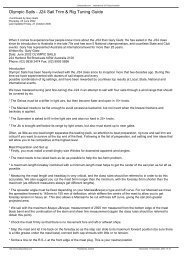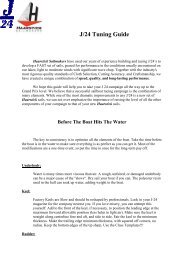Rig Tuning for Snipe Sails made by UK-Halsey ... - Sailmaker.org
Rig Tuning for Snipe Sails made by UK-Halsey ... - Sailmaker.org
Rig Tuning for Snipe Sails made by UK-Halsey ... - Sailmaker.org
You also want an ePaper? Increase the reach of your titles
YUMPU automatically turns print PDFs into web optimized ePapers that Google loves.
<strong>Rig</strong> <strong>Tuning</strong> <strong>for</strong> <strong>Snipe</strong> <strong>Sails</strong> <strong>made</strong> <strong>by</strong> <strong>UK</strong>-<strong>Halsey</strong> Denmark<br />
Spreader Length- The length of the spreader controls sidebend, where the goal is <strong>for</strong><br />
the mast to be straight from the deck to the hounds. Spreaders that are too long will<br />
push the middle of the mast to leeward while spreaders that are too short allow the<br />
middle of the mast to pop to windward. Spreader Angle - The angle of the spreader<br />
affects how much the mast will bend in moderate to heavy air. A large angle<br />
measurement will stiffen the mast while a small number will allow the mast to bend<br />
more. The <strong>UK</strong>-<strong>Halsey</strong> <strong>Snipe</strong> main is designed <strong>for</strong> a 25-28 mm prebend at the spreaders<br />
with your upwind halyard setting.<br />
Shrouds/Location- The prescribed measurement <strong>for</strong> the shroud placement on the deck<br />
is 194.0 cm aft of the stem.<br />
Shrouds- Use the <strong>for</strong>e puller to pull the mast <strong>for</strong>ward against the shrouds. The shrouds<br />
should be barely tight and the mast near straight. Raise a tape measure on the main<br />
halyard until the halyard is locked. Take the tape measure to the stern and measure<br />
from the top of the mast to the intersection of the aft deck (center) and the stern of the<br />
boat. Adjust your shroud tension until this measurement is 647.0 cm.<br />
Mast Rake- Adjust the jib halyard until you are at 658.0 cm. This will be your upwind<br />
halyard setting.<br />
Mainsail Trim<br />
Main Cunningham- Adjust upwind to keep the luff wrinkles in the bottom half of the sail<br />
(the sail should be fairly smooth in the top half). Once you are overpowered start<br />
pulling on the cunningham tighter than what the above rule states. Ease completely <strong>for</strong><br />
all offwind sailing.<br />
Outhaul- The <strong>UK</strong>-<strong>Halsey</strong> main is constructed with a shelf foot to give the bottom third<br />
of the main the broadest range of shapes possible. Adjust upwind to place the clew<br />
approximately 2.5 cm from the band to offer sufficient fullness in light air and/or lumpy<br />
conditions. For higher winds or smooth water the outhaul must be tightened, with the<br />
clew reaching the band <strong>by</strong> app. 5 m/s and higher. Ease <strong>for</strong> all offwind sailing so the<br />
shelf just completely opens.<br />
Mainsheet- The rule <strong>for</strong> upwind sailing is to trim the mainsheet so the top batten is<br />
either parallel with the boom or just hooking to weather of the boom. In lighter air the<br />
weight of the boom will prevent the top batten from opening. When this occurs ease<br />
the main out so the top batten is parallel to the centerline of the boat. Ease the<br />
mainsheet when reaching so the sail is on the verge of luffing. For downwind, ease until<br />
the boom is barely resting against the shroud.<br />
Fore/Aft Mast Puller- With the mast at the upwind setting, place a mark on the mast<br />
and a corresponding mark on the deck. This is your prebend mark. Next place a mark<br />
15 mm. in front of the prebend mark. For upwind pull the <strong>for</strong>e puller to the front deck<br />
mark when the wind is too light <strong>for</strong> the top batten to twist open to an angle parallel<br />
with the boom. As the wind builds the mast will naturally bend more, but you may want<br />
to restrict it with the aft puller to hold onto mainsail power. To depower you will be<br />
gradually tightening the boomvang (see boomvang section) while easing the aft puller<br />
(stop at the <strong>for</strong>ward mark). For reaching (with or without pole), bring the mast back to<br />
the prebend mark. For pole running pull the mast back, to make the main fuller.
Boomvang- The boomvang is used upwind in conjunction with the aft puller <strong>for</strong> medium<br />
to heavy wind. As the wind strengthens, increasing vang tension (and decreasing aft<br />
puller) will help flatten the main while controlling jib luff sag. When reaching adjust the<br />
vang so the top batten is parallel to the boom. When running the top batten should be<br />
either parallel or twisted off.<br />
Traveler- The traveler is an upwind only adjustment that shall be kept centered until all<br />
other mainsail adjustments are well into their heavy air positions. Begin <strong>by</strong> easing the<br />
traveler 5 cm to help keep the boat flat. In puffy, overpowering winds a balance<br />
between the traveler and the mainsheet must be found.<br />
Jib Trim<br />
Jib Leads- The leads should be set so the jib is quite full in the bottom third and open in<br />
the top - depending on the conditions of course.<br />
Jibsheet- Trim the jib upwind so the foot will just come down to the splash rail.<br />
Reaching trim should have the sail eased until the luff is on the verge of luffing. Pole<br />
trim should have the jibsheet adjusted so the leech is on the verge of collapsing when<br />
reaching and the foot is just taught when running.<br />
Jib Cunningham- The upwind rule is to trim it so as to have only slight wrinkles coming<br />
out of the bottom half of the luff when sailing upwind. As the wind increases, this<br />
adjustment must be tightened to maintain our rule. For offwind trim the jib cunningham<br />
is completely eased.<br />
Jib Halyard- Pull the halyard to your upwind setting when sailing to windward. When<br />
non-pole reaching leave the halyard at the upwind setting. For tight pole reaching leave<br />
the halyard at the upwind setting and gradually ease it as the wind swings further aft.

















